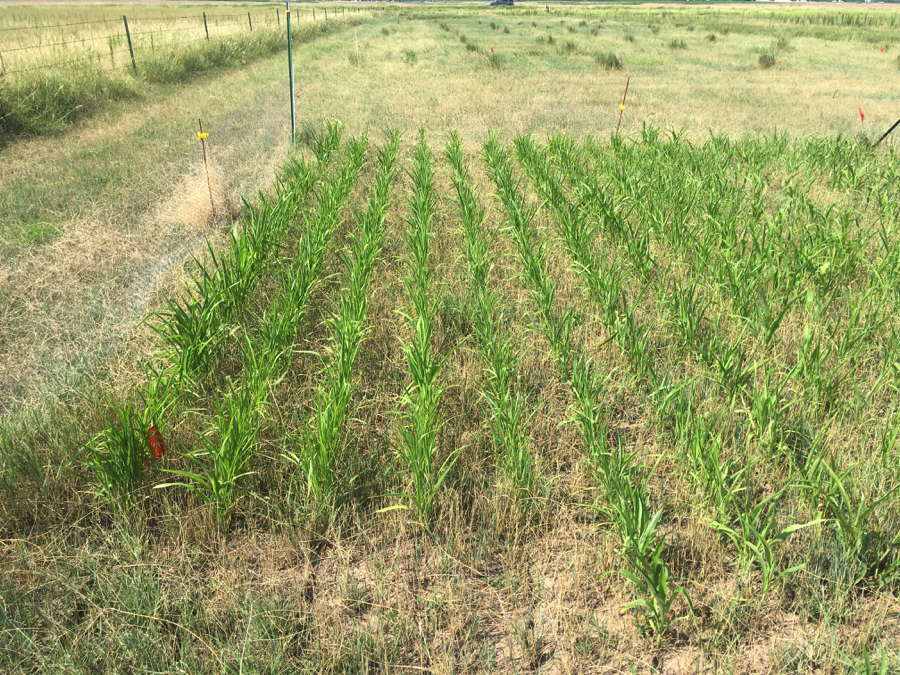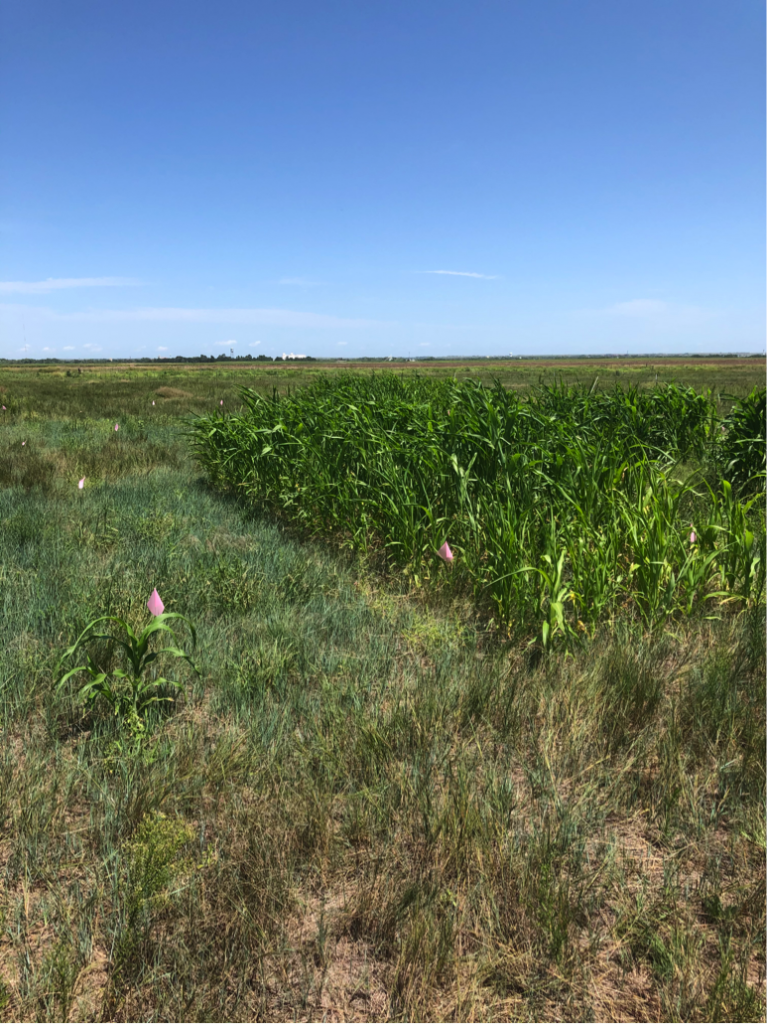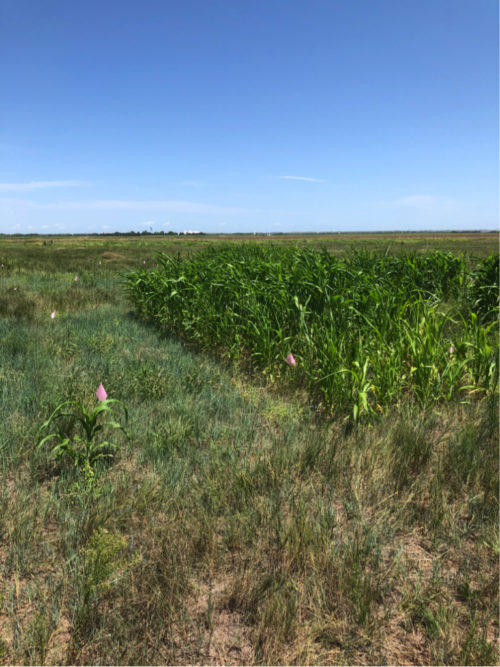By: Keith Harmoney
Conversion of pastureland into cropland has occurred at a rapid rate in the Great Plains. A reduction in total acreage of pastureland from this conversion has resulted in a decline of total numbers of beef cows in the same region.
One way to mitigate the decline in cow numbers is to increase the carrying capacity of the remaining pastureland acres. One way to do this could be to interseed a warm-season annual grass species into perennial cool-season grass pastures (Figure 1). This could increase dry matter production during the mid-summer time period when perennial cool-season grasses would be most dormant. An increase in production during this time period could result in a significant overall increase in total land area production.

Figure 1. Sorghum-sundangrass approximately 30-45 days following interseeding into western wheatgrass pasture near Hays, K.S.
METHODS
In 2020 and 2021 we tested this by interseeding sorghum-sudangrass, crabgrass, and teff into a western wheatgrass pasture at the Agricultural Research Center-Hays. First, the western wheatgrass was harvested to a height of 4 inches for forage yield in June. The three summer annual forages were no-till seeded into the plots at three seeding rates (0.5X, 1.0X, and 1.5X), using 12-inch rows. After seeding, 60 lbs N/acre was applied.
The summer annual forages were harvested for forage yield at a 4-inch height 90 days after planting.
The following spring, western wheatgrass was fertilized early with 60 lbs N/acre and was harvested in late spring to see if the summer annual forages had any effect on the subsequent growth of perennial cool-season grass.
RESULTS AND DISCUSSION
Following western wheatgrass harvest in June, the soil was dry both years. It didn’t rain enough directly after seeding to get good seed germination of all the summer annual forages. The only summer annual forage that established and maintained acceptable stands in either year was sorghum-sudangrass.
Yields of both western wheatgrass and sorghum-sudangrass were higher in 2020 than in the extremely dry season of 2021. This especially reduced sorghum-sudangrass production in the new 2021 interseeding. At 90 days after seeding, sorghum-sudangrass plots averaged 6,600 lbs/acre of additional forage in 2020. The new seeding of sorghum-sudangrass in 2021 produced a little more than 800 lbs/acre of additional forage. Crabgrass and teff resulted in no additional harvestable forage in either year.
Sorghum-sudangrass planted in 2020 reduced western wheatgrass production in the following year by 440 to 730 lbs/acre compared to where no summer annual forages had been interseeded. Western wheatgrass production following the 2021 sorghum-sudangrass seeding will take place yet in spring of 2022. Once that data is available it, along with the 2021 sorghum-sudangrass yield, will be added to the table below.
IMPLICATIONS
Establishing sorghum-sudangrass in cool-season western wheatgrass pasture at the Agricultural Research Center-Hays improved total forage production over two years, 2020-2021. There was a net increase of nearly 3 tons of forage/acre compared to the cool-season grass alone (Figure 2).

Figure 2. Sorghum-sudangrass just before harvest at 90 days after interseeding into western wheatgrass pasture near Hays, KS.
Vast improvements in production on limited cool-season pastureland resources are possible during years of greater precipitation. Alternatively, timely summer rainfall may provide an opportunity for some interseeded summer annual forage growth when early spring precipitation limits cool-season grass production. Greater forage production in turn increases the total number of beef cows the land area could support through grazing or haying.
Table 1. Effect on forage yields in 2020 and 2021when interseeding sorghum-sudangrass into western wheatgrass pasture at, Hays, KS.
|
|
Western wheatgrass yield (lbs/a) before interseeding |
Sorghum-sudangrass yield (lbs/a) |
Western wheatgrass yield (lbs/a) the year after interseeding |
2-yr combined forage yield (lbs/a) following interseeding |
2-yr combined forage yield (lbs/a) increase |
|
Sorghum-sudangrass seeding rate |
Harvested June 2020 |
Harvested Sept. 2020 |
Harvested June 2021 |
|
|
|
0 (no interseeding) |
2243 |
-- |
3170 |
5413 |
-- |
|
0.5X (20 lbs/a) |
2499 |
7180 |
2840 |
12519 |
7106 |
|
1.0X (40 lbs/a) |
2262 |
5950 |
2520 |
10732 |
5319 |
|
1.5X (60 lbs/a) |
1778 |
6670 |
2250 |
10698 |
5285 |
|
Interseeded Average |
2180 |
6600 |
2538 |
11318
|
5905 |
The full article on this research can be found in the ARC-Hays Roundup 2022 publication at: https://newprairiepress.org/kaesrr/vol8/iss2/4/
This research is a follow-up to a previous regional study at several locations that is published in Agronomy Journal. The new study published in the Roundup is one of two locations, with the other location being Meade, NE in smooth bromegrass pasture.






